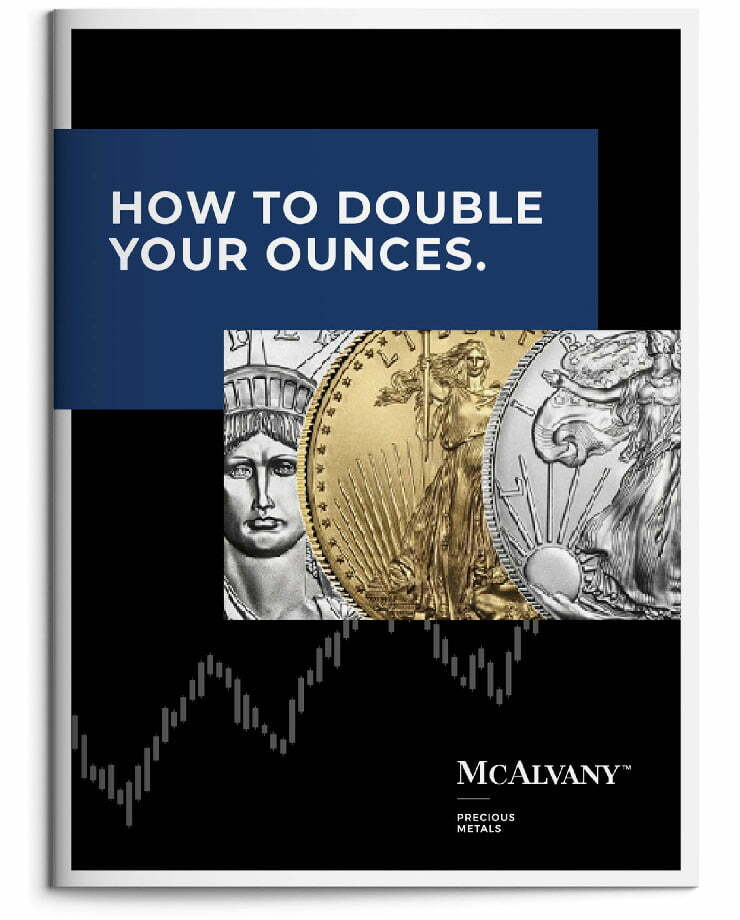Podcast: Play in new window
This week, we’re joined by Keith McCullough, founder and CEO of Hedgeye Risk Management. Keith is a former hedge fund manager and a leading voice on building data-driven investment processes that take emotion out of decision making.
In this conversation, we discuss:
- How top hedge fund managers approach risk and opportunity
- Thinking about money through a “four quadrants” framework
- Common mistakes investors make when emotions drive their choices
Special Offer:
Hedgeye is offering McAlvany listeners a free, no-strings-attached month of access to some of their top research tools through the Elite Macro bundle. No credit card required.
Learn more and sign up here: hedgeye.com/mcalvany
Thanks for listening!
“What the companies couldn’t tell you was when GDP growth was going to slow and/or inflation was going to slow at the same time, or if inflation was going to accelerate and we end up with stagflation because growth is slowing in the face of inflation, accelerating too quickly. So I kept asking myself, why the hell these guys don’t know how to answer this question? And then I understood why, because they don’t have a process for them. So that’s where I came to the quads. Quads—so substitute for revenue growth, pod one, I substituted the rate of change of real GDP growth for countries, and for pod two, cash flows, I inserted inflation, the rate of change of year over year inflation.” —Keith McCullough
* * *
Kevin: Welcome to the McAlvany Weekly Commentary. I’m Kevin Orrick, along with David McAlvany.
Our guest today, Dave, basically tries to look at the world the way it is, not the way he wishes it to be.
David: Keith McCullough joins us from Hedgeye where he’s the CEO, and investors have had the opportunity to ride a roller coaster of volatility in recent weeks. From Truth Social posts to unending economic statistics and the occasional Fed official taking the mic. There are new and unpredictable inputs for investors to consider, which makes a standard efficient market hypothesis application of collective wisdom hard to benefit from.
We’ve often explored our frameworks and indicators for credit markets and liquidity dynamics which directly affect the financial markets. We have our own processes and frameworks and disciplines, and we’re constantly exploring complementary frameworks like the social and political analysis we frequently refer to from a return guest on the commentary, Neil Howe.
His fourth turning framework has for many years provided an interpretive lens for generational change and volatility of a non-financial nature. So we have models, we have frameworks, we have interpretive grids. None are perfect, some are incredibly helpful—some more so than others.
That’s my introduction to today’s conversation with Keith McCullough, CEO at Hedgeye. Imagine my surprise to learn that Neil Howe and Keith have worked together for years. Not a surprise. Another aha moment was learning that Hedgeye cartoonist Bob Rich is a part of Keith’s team. I’ve been laughing at Bob’s daily cartoons for the better part of a decade, not knowing the organization he was a part of. I mean, yeah, every one of them says Hedgeye on it. It’s probably a measure of density that I didn’t connect the wit and wisdom from Bob to Keith’s group. It’s a little like Gary Larson got an MBA, became a professional trader, and then with gallows humor peeled back the Wall Street layers of opacity.
So whether it’s the cartoons or Keith’s approach to risk management, I keep saying to myself, that is so good. So today, we’ll get to know the organization a lot better, why we have so much compatibility. We’ll cover that as we go, and of course we’ll look at the subscription services that Keith offers, which are invaluable for the investor rolling up their sleeves on a daily basis. We’ll cover that as well.
All right, Keith, let’s get started. We need backstory to appreciate what you do and why you do it. We’ll cover the process in a moment, but dive in with a whirlwind bio from Canada to New Haven, to hedge fund trading, to getting fired in 2007, launching Hedgeye in 2008. Might even mention what it is that ties together being a top scorer in the Yale hockey team with also being a top man in the penalty box.
Keith: Well, there is a lot there, David. Thank you for having the conversation. Thanks for having me on your podcast. I appreciate it.
I guess there’s a long history whenever you’re trying to traverse your own investment career. So for me it goes back, I’m certainly not going to bore anyone with the 25 years now that I’ve been doing it, but my experience with gold in particular started at a very young investment professional age. So right after the hockey career ended, where I unsuccessfully did not make it to the NHL—let’s just say that—but I ended up on Wall Street as an analyst, I started following gold companies at a very young age. I mean back in 2002, 2003.
So that’s just background in terms of how long I’ve been trying to risk manage both physical gold, the price, and the stocks related to gold. So that takes me all the way back, but just to step all the way forward to Hedgeye and the goal and the opportunity, I’ve always thought that the biggest opportunity is to democratize access to the decision-making process of a real hedge fund. Hedgeye, you put your eyes inside of a hedge fund, what would you see? And hopefully we’ve been successful in communicating that process, coaching people through that process, because what you really see is a process. You see a process of decision-making.
You see—in our case I wouldn’t call it a rigid rules-based process, but there’s certainly rules embedded in the process from signals to economic quads, which I’m sure we’ll get into, from a methodological perspective. But my goal was to help people preserve and protect their hard-earned capital. Help them avoid drawdowns and crashes in what they’re typically long, which are stocks and bonds, and broaden their horizons with what we now call go-anywhere strategy, where you can buy anything—quite literally any asset class or anything, like gold in particular where we think that there’s always a place in the portfolio for sure.
And there are certain times in the cycle itself where one should own a heck of a lot more than they do at other times, and own a heck of a lot less of what everybody else owns in the meantime, which would probably— I affectionately call them the Bag 7 or the former Mag 7 is the Bag 7 stocks. If all you did was flip that into gold three months ago, and that’s a super short-term view within the long-term cyclical view that we hold, a pretty good example of that.
So that’s been the goal. If you could give the people access points to be able to learn how to fish, learning how to fish is a better way than just handing them fish or stock picks, or it’d be nice if somebody was handing me ounces of gold, but that’s a different topic altogether.
David: Well, we’re excited to be working with Hedgeye, providing precious metals, trading strategies, and optimizing portfolio construction for your clients. I feel like it’s a tailor-made fit between McAlvany Precious Metals and Hedgeye.
Your process begins with hard work and discipline. It’s driven by a team of capable analysts, and it’s really a risk management protocol. Start us with the importance of a repeatable process and the significance of humility.
Keith: Let’s start with the second part first, I mean, because it’s the most important part. I’d say the behavioral part of an investor’s traverse is the most important thing. So again, having the humility to know that you really don’t know anything. I mean, we as human beings are just part of the universe, fortunately, and fortunately—I think it’s fortunate, some may quibble with it—that the universe is uncertain. It’s a constantly evolving universe with colliding forces and fractal math. We call them emergent properties and similar sets and different— I wouldn’t call those fancy mathematical terms, but there are things that are clear and obvious in physical nature that appear to be, at least to me, very clear in markets.
So having a rules-based process that really is designed— A lot of this brings me all the way back to 2002, 2003. If I was, for example, at the PDAC in Toronto trying to analyze what a bunch of gold executives were telling me about their junior mining companies, that requires an extreme amount of arrogance on both sides, where both the company’s feeding you their Pablum and you’re taking it as a newbie analyst. That would be arrogant to assume that you know what to do with that. Humility would be having the experience of all your mistakes and understanding that the market is very good—just like the universe is—through its natural laws of giving you plenty of risk management signals and heads-up, and really clues as to when to do or do not do something.
Doing nothing is of course a good investment decision. Sometimes doing something aggressively is also an important decision some of the time. And getting out of things is clearly something that very few people focus on as well. So I wanted to build a risk management process where I was feeding the intuitions of the mind, of my human tendencies, of my amygdala, and my fear center in particular. That would be a very good thing to fade because that’s what, typically—if you look at all the mistakes that I’ve made, at least—they do fall squarely in the face of a fear or a feeling, which is in and of itself obviously a feeling, fear is.
So designing a risk management and rules-based process that could just let— Essentially, I let the machine—I call the global macro market the machine—but using machines like stochastic models that we’ve built and AI plugs that we’ve implemented—anything that we can find technologically that helps us get to the answer a little faster—with, again, just assuming that we don’t know, embracing uncertainty instead of seeking what I think is the greatest disease of the mind of an investor, which is the seeking of certainty. Well, it’d be nice to have, and that’s why people feel certain ways about certain things. It’s just not what you get.
So like I said, we built a process that is really market-based signals so we can get into the rules embedded therein. Signals are front running the future state of the economy, not unlike how emergent properties ahead of an avalanche would be predicting or forecasting those types of conditions.
So again, and we look at those signals as front running economic conditions. And again, I’m sure we’ll get into what those quads are as we like to define the economy both explicitly and obviously mathematically through the lens of the quads. So really the rules-based process is the signal, is front running the quads, and if we know what quad we’re in of the four economic scenarios—much like the four seasons of the weather, to use the same analogy—then we have a fighting chance of being more right than we’re wrong. Let’s just start with that, which is a good place to start.
David: There’s so many different cycles that one can engage with. You’ve got Howe’s sociological cycle, you’ve got Kondratieff’s cycle, which is more macroeconomic in nature. When you talk about being a full cycle investor, when you think about full cycle investing, how does that differ from what Wall Street often slips into?
Keith: Well, if you think of a cycle in its most simplistic heuristic, which is a sine curve, where is the economy, or where is any economic data point, because they all have their own cycles. Where are you on the sine curve? So you just draw a sine curve and you’re like, if you’re coming down the top part of a sine curve, you’re decelerating, or the economy is decelerating. If you’re coming off the bottom part of the sine curve and incoming data is accelerating, then you’re accelerating off the low of the cycle.
So what I’m constantly trying to measure and map is, where are you on that full investing cycle from the top to the bottom and back again? So again, what you find is that that’s what cycles do. They cycle, right? So they accelerate, then they decelerate and then, they decelerate at a faster pace. And then, they decelerate at a lesser pace, bottom, start to accelerate, et cetera, et cetera.
So when I say investing across the full investing cycle, and applying that to what certain assets and asset classes do, depending on where you’re at inside of that cycle, that’s the most critical answer to solve for. There are certain parts of the cycle in particular, the growth slowing cycle—where gold in particular absolutely loves that, and that’s what we’ve just witnessed most recently, for example.
David: Brothers from a different mother. That’s what crosses my mind when you talk about top-down macro analysis combined with bottom-up fundamental research with an overlay of proprietary risk management signals. We manage money that way. Hedgeye is the first and only risk management service for the self-directed investor. Maybe you could illustrate how your risk management services differ from, say, an investment newsletter service.
Keith: Well, I’d say the first and most obvious is that ours gets you out. Maybe it sounds funny to—probably not to most Americans. The Canadian accent out is on the outs sometimes these days. Sometimes it’s fine. And then, who gets you out? I’d say that very few, if any, newsletters do because that’s not the point. The point when you’re writing a newsletter is giving you a narrative, and that’s, I think—I am generalizing here. There are some newsletters that are clearly of value. Of course, I’d say that the one that Neil Howe produces, for example, would be one of them, right?
That said, demographics on the long-term sine curve are one of the more irrefutable or empirically obvious truths, whereas a lot of things that you’ll find in newsletters are opinions. The way the world could be. The way the world should be. The way the world could and should be. Well, I tend to go with the way that the world is, and the way that the world is the day after that, and the day after that, and how that’s handicapping the next three to six months and potential next three years. We never go beyond that.
So that’s, I think, the biggest differentiator. You take something like uranium, for example, which would be a good example of something you’d find certain newsletter writers were extremely bullish on, and a lot of people, including ourselves, were long it. But you really shouldn’t be long uranium or anything other than gold when you hit the other side of the cycle, when you hit quad four, for example. Quad four is extremely bearish for bitcoin and uranium.
So you take two big things that the average Joe out there might own if they’re not buying stocks and bonds because they believe in the newsletters or they have a belief system that would have them buy other things. I think that that’s important. I mean, it’s certainly— To diversify is a critical component of building one’s wealth, but so is risk managing the cycle so that you get out of these things before they collapse and crash, which is exactly what uranium just most recently did.
So that’s that, I’m not a gold bug, I’m not a perma bear, I’m not a perma bull. I mean, I’m constantly just trying to help people make good decisions within the probable outcome that is staring you in the face.
David: For the self-directed investor, what you’re giving them the opportunity to see is a review of the facts which are ever-changing, and the actions which you would tie to what is happening—and things change that frequently, day to day, even minute by minute.
The self-directed investor you provide resources for is a part of a larger complex of professionals that lean on your insights as well. Not trivial, 10 trillion in managed assets amongst your institutional clients. What is it about the 60/40 model, target date funds, and passive indexing themes so popular today that you find lacking?
Keith: I think the biggest problem with passive is the same problem I’ll generally come back to, which is passive doesn’t get you out. Most investment products, in particular, if they’re properly marketed—and I mean properly quite literally because there’s a marketing plan behind that, right? Here is why you should hold this for the long term—and they don’t quite put it in bold letters—and also pay us an asset management fee to do that. That’s a thing.
I’ve got a tremendous amount of respect for Jack Bogle and all that he created with Vanguard, and the passive business was great, just by virtue of you having lower fees, right? So if you’re going to buy and hold anyway, then why wouldn’t you do it with lower fees?
Well, that’s pretty straightforward. I mean, it was brilliant at the time because there weren’t lower fees. So that, again, still doesn’t solve for problem number one. And I do find it interesting, David, that I wrote my senior thesis at Yale about Warren Buffett’s strategies and what may help augment his strategies in certain times like the 1970s, like a short-selling strategy for example. But back then— And Charlie Munger would actually probably— I think he’s the author of this, but rule number one of investing is don’t lose money. And somewhere along the line in the last 25 years, and multiple times at that, and certainly post-pandemic where everything turned into investing is more like gambling, like YOLO, or only invest what you can lose.
You’ll hear these ridiculous comments that younger and older people make. It’s more not about your age, but more so you’re engaging in markets and at what point in your life you try that, but that’s a big deal. I mean I think that that’s something that we’re constantly trying to make sure people understand is that all that was created prior to having a fully built-out risk management process that protects against drawdowns in capital, and therefore solves for rule number one, don’t lose money when everybody else does.
The technology and these lower fee products have really helped perpetuate the people’s ability to, I guess, execute on a properly—what I would call properly—diversified portfolio. Because, just to use something really basic, I don’t know if you’d call this evolution or technology, but the GLD. Prior to that, you couldn’t buy paper gold. You couldn’t get exposure to gold. And I know that you guys have thoughts on that obviously, but I do quite appreciate what the business has created in terms of low-fee products. But that doesn’t mean I carry the flag of passive investing, buy and hold, et cetera, et cetera.
David: Yeah, it was in 2016 that index investing via the ETF surpassed the assets under management of the money managed by professionals in the hedge fund space. So you’ve got the advantages of lower fees, and tied to that, sort of the Wall Street truism: you can’t time the market. So you’ve got people loading into the ETFs, and it is sort of a buy and hold strategy for most. What do you see as the structural issues and weaknesses of that indexing trend?
Keith: Well, what’s interesting about that, and that’s a really important call-out. I mean I really have a deep level of respect for both your history, David, and your father’s, and your company’s history because you’re encyclopedic in terms of your front foot. Does everyone know that passive eclipsed active, or passive— I always show passive breaking out relative to hedge fund assets under management in 2016. Does everyone know that? No, but it’s a real important point because it asks the most basic question: why did that happen? Well, because you started to have the access and ability to execute across many, many different markets other than just US-listed stocks in a liquid way, a low-fee way, and that was the thing.
I mean on market timing, it’s kind of funny, right? I mean everything is a bit of a joke when you turn it upside down, when it’s a Wall Street saying like you can’t time the market. Believe me, many people, if not 90-plus percent or 99% of them—certainly if they’re amateurs or individuals with no process or model I’d put it closer to 100%—believe them. They can’t time markets, so they don’t have a process for that. But the entirety of the hedge fund business, like AUM, and if you go back to that 2016 period, I mean you’re talking, what, two and a half, three trillion in assets under management at that point, global hedge fund AUM by specifically timing markets. The world’s billionaires wouldn’t have become billionaires if it wasn’t at least possible to time markets for the few.
And I’m not talking the very few, I’m talking about the few that figured out that that was better than just, as I call it, buying and bag holding sometimes.
So yeah, the game changed materially, and from that point on in 2016, what you’ve actually seen is that the machine has really taken over through the lens of passive ETFs and in some cases active ETFs because that’s where the flow is. If you think of anything, which most gold and precious metal investors should be familiar with, stock to flow ratios, just think about the flow. The flow just went vertical starting really not in 2016, where that was an important point, but it started to go vertical coming into and out of the pandemic, from that point on. What was happening top down to the decision making of endowments of even 60/40 decision making process, which for a lot of retirement accounts, that’s a huge flow.
All that really explains what’s going on day to day as opposed to some fundamental thing that people are constantly trying to figure out. Not to keep going on this, but Benoit Mandelbrot taught me a long time ago that most of the time in markets, these short-term moves are just Brownian motion, nothingness, but the cycle itself is somethingness, and what we’re talking about, there is much more of a secular trend that I don’t see the catalyst to change it. In fact, it continues to be more amplified by the year. I think we’re just under 10 trillion in AUM enlisted ETFs, currently over 3000 ETFs in the world which we analyze every night. We have our own process to incorporate what all those things are doing and where the flow is coming into and going out of on that front.
So that’s a big part of the process is just embracing the secular shifts towards passive and ETFs, and understanding that that can really help you build what we call a go-anywhere diversified portfolio.
David: So if it’s fair to say that a part of the weakness of indexing is the passive posture investors take in portfolio management, maybe you would add to your earlier comment, you’re attempting to democratize access to the process that a hedge fund employs. Maybe to democratization you would add empowerment because what’s lacking is the process and model.
Keith: Yeah, the reason why people don’t do things is because they don’t have an opportunity to do it. So providing access, providing the process, providing, in our case, Hedgeye University, and I actually just published a book for free, for people to download. It’s an E-book and I made it free just so that they could have a fighting chance. And it’s not to say you’re going to have a fighting chance to become a billionaire. You’re going to have access, to your point. You’re going to have resources, you’re going to be able to try to learn at least some of the process—or all of it that, in my case, I use. And guess what I mean? That’s constantly evolving and being updated just like anything else in life. Why am I not allowed to upgrade my investment process but you’re allowed to upgrade your iPhone? I don’t know.
I mean that’s dumb. Why hasn’t 60/40 been upgraded since the beginning of 60/40? I mean that’s even dumber. I don’t know, so I think most of the people understand that. It’s an interesting thing in particular when it comes to institutional investing and how it ties back to the people’s consensus asset allocation, which does approximate a 60/40 stocks/bonds portfolio with no gold in it as an example. I mean a lot of that is just institutionalized dogma, where if you’re going to get paid to keep selling the same thing and not evolve it over and over and over again, you’re going to keep taking those coupons, until the people realize that everything else that they love in life, including AI, asks you why you don’t change it entirely.
David: You mentioned two important resources, Hedgeye University and the book that you’ve made available for free to download, Master the Market. If any of the listeners want to go to hedgeye.com/mcalvany, is a landing page where you can get all the information you need there and get a solid introduction to the Hedgeye offerings. Again, that’s hedgeye.com/mcalvany.
Macro analysis features prominently in your services, macro considerations being the place where many analysts get blindsided. Your own evolution was from what you called the pods to what you now utilize, the quads. It is sort of an evolutionary or iterative process. That’s been important for you—it is for all of us. How did you adapt the pods to accommodate macro data, what you now use, the quads?
Keith: It’s in many ways the story of our lives, right? You learn certain things in certain environments and then you either have the creativity and wherewithal to expand your horizons and battle test them in new environments or not. If you look at anybody who’s achieved anything with some level of mastery—and I don’t mean mastering the return or the output of the process, I’m talking about mastering something that you built on your own—that’s where it comes from. It comes from your own experience. Where else would you start?
You can get a lot of experience by reading books. I’ve tried to read one every 10 days. That’s kind of my pace, and I think that that’s critical because it’s constantly helping me backfill and question—backfill the process, question the process, evolve the process, et cetera.
So when I look at this pod to quad, so my initial—going all the way back to 20, 25 years ago—my job as a buy-side analyst was to analyze companies. Like I said, you go to the Prospectors Development Association Conference. I think that’s what the PDAC still stands for. Correct me if I’m wrong. I think I told you this before, David, which is I remember going. I quite liked it because I was, like you said, a junior hockey player at heart and I’d kick back a pack of cigarettes as quickly as the next person. Then you go into the conference in Toronto in the main conference center and there’d be a bunch of guys hacking darts and it’d be a room filled full of smoke and 50-year-olds. And at the time I was 25, so I thought that was pretty cool.
I was back in my hometown, kind of like a home game for me—not my hometown. I’m from far north of that, in Thunder Bay, Ontario. But that was my job. Go find companies, build a model, and make sure—the rule number one for the hedge fund that I worked at was make sure—you can tell us when the pod one, as we call it, revenue is accelerating and if pod one and pod two—pod two is your cash flows. If your revenues and cash flows are both accelerating at the same time, then you better really make us aware of that on time because we want to buy a lot of that before the world realizes that that’s what’s going to happen for the next multiple quarters or years in some cases.
And then pod three is a capital allocation pod, which I’m not going to bore people with right now. Just keep that in your head, though. So you have pod one, either decelerating or accelerating. Of course if you own a growth stock and you tell your boss—or learn pretty quickly if you don’t tell your boss—that the coming quarter is going to be a deceleration in revenue growth and it’s this super fancy growth company that everybody owns, well you’re going to get impaled that day and you probably don’t want to tell the boss that you knew that that was coming. So again, just try to get what we call the ROC, or the rate of change, correct on pod one revenues and pod two cash flows.
And what I came to start to think through was like, well, you got all these people who do this thing called macro, and you got a lot of companies out there that talk about macro, generally speaking when it’s hurting them, as a crutch or as an excuse, and when they’re successful of course it’s never because of the macro. It’s never because of the cycle. But there’s always this thing that I had to know, studying companies. I had to meet with management teams pre-reg FD, that’s pre-regulation full disclosure, where you could get any information. So what the companies couldn’t tell you was when GDP growth was going to slow and/or inflation was going to slow at the same time, or if inflation was going to accelerate and we end up with stagflation because growth is slowing in the face of inflation, accelerating too quickly.
So I kept asking myself, why the hell these guys don’t answer this question? And then I understood why. Because they don’t have a process for that. They’re advised by bankers, right? Bankers don’t do rate of change models, they do marketing, they do deals, they do brokering. So that’s where I came to the quads, and I try to keep that story as short as I can, but quads, so substitute for revenue growth, pod one, I substituted the rate of change of real GDP growth for countries and for pod two cash flows I inserted inflation, the rate of change of year-over-year inflation. Of course, we measure and map it now sequentially, monthly, et cetera. But that’s where it came from.
It came from the same behavioral reality, which is much like a company. If growth slows and it’s a growth stock, the stock starts to go down. In some cases, it crashes. If an economy starts to slow, well now bonds go up and gold goes up. Okay, that’s pretty important. If I can go from owning everything that’s growing in pod one, or revenue growth, to everything that goes up when growth is slowing, well, I don’t have to incur rule number one. I don’t have to lose money. I don’t have to have a crash or a draw-down by staying with my former position. So that’s how I came up with it. I was just translating knowledge or experience in the field modeling companies into a process that should— I didn’t know if it was going to work. Ultimately it works.
Hedgeye’s now going on 18 years old. And if there’s one thing, David, that institutional investors pay us for, it’s where are the quads? If there’s a most common question anyone is going to ask me, it’s going to be “Keith, are we still in quad four? Or Keith, when do we come out of quad four?” Because everybody knows what quad four means. Quad four means bad for the stocks that most people own. And in the case of go-anywhere investors, quad four is the— Quad four and quad three is where gold back tests—and most recently certainly proves its back tests—does quite well, and goes a lot higher, while the things—stocks in particular—that everybody owns go down.
David: So again, your quads, you’ve got— Basically, it’s an X and Y axis with the growth of either GDP or inflation. And then you’ve got those quadrants which factor those four things in. Forecasting for you integrates the macro themes of economic growth and inflation. And based on those two sliding factors, an increase or decrease in inflation or an increase or decrease in GDP growth, with actually policy being a third factor that you bring in, you then lay out allocation parameters. So one is assessing the context that you’re in, and then again your process is moving you towards actionable items. The allocation parameters, walk us through that.
Keith: Yeah, and so if you go— It’d be easier to show, and we do, again, it’s in my book, the E-book, and it’s also on Hedgeye University because, again, the playbook, just like any manual— I can give you a manual on how to go fishing in Northern Ontario, David, but you’re not just going to be able to catch fish by having that manual. The manual is critical, but the manual does not catch the fish, right? So I always tell my analysts, the spreadsheet you’re building is not going to generate the alpha. It is critical to have the spreadsheets and it is critical to have the models.
So just as a starting point, again, just to review what you said, it’s a two by two model, like I said, growth and inflation, GDP growth and headline. We’re talking about headline, year-over-year CPI. And when people say, “Well, inflation could be something else.” We’ve reviewed everything else that inflation could possibly be defined as, and it doesn’t back test as causal for what I want to invest in, because all I’m trying to do is create a shortcut to get to the right answer before the crowd does.
So we have quad one, that’s when growth is accelerating and inflation is decelerating. That’s what we call Goldilocks. That’s the 1980s, 1990s. That’s why under both political parties people were somewhat happy. Quad two is what we call reflation. That’s where both growth and inflation are accelerating at the same time.
It’s not about whether economies are good or bad. It’s whether they’re accelerating or decelerating. It’s all about the ROC, it’s about the rate of change. Quad three is stagflation, where, as I pointed out, inflation is accelerating too quickly and real growth is slowing in kind. That’s the worst for the human being or the consumer because of course that generally equates to—which actually is happening in the US right now where your currency or your purchasing power is falling, real cost of living is rising, and all things beyond that gets you to a place of slower growth. And then finally, quad four is disinflation or worse, which we’ve had in my career multiple times, deflation.
That’s where obviously not a lot of things work, and that’s the best time to be long. But what’s interesting about gold— So again, we take all these things, just to use gold in particular is an example—I could tell you anything that ticks, fixed income, gold, currencies, commodities, equities, credit, subsectors of equities, subsectors of credit. So in a growth-slowing environment, gold is one of the top things to own in terms of asset allocation. When you’re in quad four, it’s fixed income, Treasuries, and gold. In quad three, it’s gold and commodities and fixed income. So it’s interesting but not surprising that commodities go from a very good place to be when inflation is accelerating in quad three, stagflation, to a bad place to be when you get disinflation because the commodities that inflated are now disinflated.
So it’s pretty straightforward. I mean, I think in my own mind, that’s actually the biggest challenge is that most of this is like putting on one skate at a time. I don’t overthink it. I know what the back tests are. I know what to do if I know what quad we’re in. Quad two, for example, is the worst time to own gold. It’s either sideways or down. Pace of interest rates rises in quad two, and that in particular, dollar up, interest rates up, bearish for gold on the margin. So that’s when, typically, I’ll have my lowest asset allocation of gold. And all my physical gold will still be in the safe, of course, but that’s where paper gold will probably be a short [unclear] and an underweight.
So that’s how we think about it. Everything that ticks finds itself positively on the margin or negatively in each of the four quads.
David: So our listeners need to go to hedgeye.com/mcalvany, download that book. Go to page 27. You have a visual in your book, Master of the Market, which shows the best and worst performing asset classes by the quad regime. It’s worth memorizing.
So this is real simple, hedgeye.com/mcalvany, download the book, go to page 27 and spend the time. If you don’t have a photographic memory, you’re going to have to work a little bit harder. That’s okay. Memorize it. That I think is a super useful tool for seeing the interrelationships between assets and how they perform differently in a unique context. And you’re talking about the macro context.
On to your trade, trend, and tail model. It reminds me a little bit of Charles Dow describing the tides, the incoming sets, and lastly the individual waves. Maybe it was one of his Dow theory acolytes, Rhea or Hamilton, that used that language, but the tide coming in or out is the larger context, well-supported over a longer period of time. I think you give that about a three-year time frame. The tail, as you call it.
The sets, very much like your trend, are of intermediate duration. The waves are on par with your trades. Something that is actionable today and you may reverse that trade tomorrow or within a week or two. How do you operate with this trade, trend, and tail model? Can you break down those timeframes for us a little bit more?
Keith: To your point, that page 27 in the book is useless unless you have the signal, right? That’s just a starting point on the way that the world has been. That’s the way that asset classes have back tested against the conditional factors that are growth and inflation, whether they’re accelerating or decelerating in the four combinations embedded therein. Now, trade, trend, tail is my signal, okay? So What do I want? I want to be multi-duration and I want to be multi-factor. Multi-duration is what you just rattled off, which is, I want to understand and have a signal on the short term. We call that our immediate term trade, three weeks or less in duration.
The reason why I came up with that—again, through experience. I was at a hedge fund that used one month price momentum as the gating factor on what we should do with our exposures. So I’m like, “Wow, maybe I should be a week early.” What a genius move that ended up being. It was probably the smartest, easiest move I’ve ever made in my career in building a signal. And then I got into multi factors. So again, we have three different durations. Trades are three weeks or less. Trends, to your points, are three months or more. That’s really important because that’s how the quarterly type investor generally cares. And then anything beyond three years, I have no ability to predict anything accurately that anybody should listen to. So that’s why I use three years or less. And by the way, it’s very atypical for a cycle to last more than two and a half years on inflation or growth anyway.
So it all fits inside of the same process. And then, I’m just quickly on multi—that’s multi-duration trades, trends and tails. I would never look at a price of something without that multi-duration lens. So again, it’s like a 3D look at it. And then, multi-factor, I think a lot of people— I don’t want to insult anyone, obviously, but I wouldn’t use it. If it worked, I would use it. Using a single factor model as your signal, like price momentum, where is the moving average? I mean, that is so pre-internet that I can’t even say anything else.
What we’ve built is using fractal math. So again, you would take at least three factors, price, volume, and volatility, and look at their relationships and rate of change terms.
And then start to measure and map what we call fractal dimensions, or what drives something to be a bullish trade after being a bearish trade. To being, from a bearish trend— More importantly, the trend duration is the most important duration because it back tests with the highest success rate if you get the trends right, because you’re riding winners for longer. Trends, when something undergoes a phase transition from bearish trend to bullish trend, and it’s the economic quad that that thing should be a bullish trend in, those are always my biggest positions, for example.
David: So thinking about the multi-factor brings us to what you describe as the risk range signaling process. And it is again derived from the dynamic mix of price, volume, volatility, a probability study for what a ticker, of what an asset class is likely to do next. Ranges are updated for you I think on a daily basis. How does that relate to the old adage buy low and sell high?
Keith: Well, ironically now if it helps you buy low and sell high, in a world where a lot of people chase high and freak out lower. It is amazing, people don’t want to buy it unless it’s going up. It’s bananas, but the risk range is built to do just that. So the risk range is designed to, again, if you go back to the beginning of this conversation, having the humility to realize that you don’t really know anything at all. So what you do know is that you prefer to buy low and sell high, to your point. So where I want to buy is at the low end of the risk range, and where I want to sell is at the top end of the range. So that’s my answer to the question.
Now building the model is much more difficult, so I don’t give away the keys to the algorithm on that. But again, what’s really being augmented in terms of our process here is the speed of the machine and how quickly they react in that three weeks or less window. And it’s really the calculus of the volatility of volatility.
So when you look at something, like people will be familiar with volatility through the lens of the VIX. When the VIX goes from 17 at the end of March to 52 within two weeks in the first couple of weeks of April, well, most human beings don’t know what to do with that other than panic. Now, our signal would say that, at 17 on the VIX, that was a do nothing. But a week later, at 21 on the VIX, that was a do something, which is de-risk and up your asset allocation to gold because the gold signal was doing the opposite in the same calculation. And that’s a real important window of time.
When I said Mandelbrot taught me, the most important book that I’ve ever read is the Misbehavior of Markets by Benoit Mandelbrot. It’s not about the average of things or the valuation of things, and it’s not about the fundamental thing every single day because it’s all about Brownian motion. It’s about the particular thing that happens at the particular point in cycle time—or in clock time, as Jim Gatheral would call it—in the volatility surface.
So my answer to that was like, okay, that all makes sense. And that’s kind of the story of my professional life is what— If something makes sense to me mathematically, then I try to impose it into models, test them—they break, they succeed, they fail, et cetera. And the one thing that’s really worked is that the volatility of volatility, if it’s breaking out, then you need to get the hell out of whatever that asset is, and if it’s breaking down, then that would be a signal that the worst is behind you and you could potentially have an entry point at lower prices. So again, potential goes up. So if it’s at the low end of the range now, I’d become a buyer as opposed to buying every damn dip which is not a dip in the S&P 500 when the VIX goes from 17 to 52.
David: So would you describe the risk range signaling process as having a more contrarian bent as opposed to playing momentum?
Keith: Yeah, by design, it’s built to fade Myself. I’ve learned that it’s less insulting for people to say that, and it’s like I built everything I’ve built to fade what’s in my brain. Fade my emotions. So that’s exactly what it is. I mean when gold is hitting all time highs, it’s very close to the top end of its range, and I’m selling SOME. I have to put it in all caps. I put selling in lower caps and some in all caps because that, too, even that—doing things incrementally—is not what people who haven’t done this for very long have been coached through or taught, but it’s what I do. So by definition— Some people call me Darth Vader, for other reasons, but I am fading. We’re constantly fading, whether it’s you’re fading as in buying when things are down and people are fearful or you’re selling when people are getting greedy and chasing [unclear].
David: So let’s take together the trade, trend, and tail model, bring that and sort of merge it with the risk range signaling. Is being at the top of a risk range different when a trade, trend, and tail are all in alignment? And I think if Rothschild’s quote, “Buy when there’s blood in the streets and sell too soon.” How too soon is too soon?
Keith: Well, of all the mistakes that I’ve made historically, that’s one of the more consistent ones, right? You sell winners too early. Fortunately, in the last decade or so I’ve basically made it a rule where I can’t do that. So selling too late, I think, is more of the way that I would think about it. So let’s just use— We can use gold actually because gold is bullish trade, bullish trend, bullish tail. So it’s what we call bullish formation. It’s bullish on all three durations, and its risk range is as bullish as bullish gets because the top end of the range is implying new all-time highs, right?
So the only second-best hand in my game of poker to that would be something that’s just signaling higher highs in the risk range. Higher all-time highs is more bullish than any other higher highs. So gold’s all-time high, I use closing prices. So again, all-time closing high on my closing time was 3434, and it’s top end of its range is 3464. So again, the top end of the range is a higher high, but it’s also a higher all-time high.
So in those types of situations, you will get absolute panic like you just did in the last two weeks in gold, just because it stopped going up for a couple of days, which is ridiculous. I mean, for me, it’s ridiculously obvious what to do in that scenario, provided that it’s not lower highs. Now, lower highs would give me more of a pregnant pause or I’d be buying less aggressively.
So there’s a series of decisions inside the decision-making process, right? And once something starts to signal lower highs and then breaks my immediate term trade level of support, well that would be my signal to reduce the gold position down to at least its minimum, and it would certainly be a healthy warning that I might within one, two, or three months be entirely out of it, because it would break trend. So again, lower high, breaks trade, breaks trend. And you don’t have to worry about nailing tops and bottoms because you’re executing at the margins of the risk ranges.
David: Yeah, I think one of the things that you bring to the conversation is that perfect is not the goal. You’re not trying to win 100%. If you won 60% of the time, that’d be fine. And a part of not being too late is the incremental moves that you might make. When we’re managing a portfolio, it might be at 25 to 50 basis points at a time. That is not how investors think. It’s kind of an all or nothing, I’m in or I’m out, and when should I be completely in or when should I be completely out? And that’s really not the goal, is it?
Keith: No, no, no. All in or all out is what a gambler does, an amateur, right? A professional gambler is making incremental bets at the blackjack table and is not hitting on sixes. So yeah, we’re making incremental bets, and a bullish trend, if you just want to buy and hold, you’re going to really miss out on the full return, the full potential of the return. If something goes from 10 to 20 and you only make 10, you’re not doing it the way I do. You can make 12 to 15 on a move like that.
So yeah, I think that if you’re going to be active, right, David, that’s another thing. You don’t have to be active if you’re going to be buy and hold or more passive in your stance, just understand that that’s your stance and don’t whine and complain about everything that’s happening in between because that’s your stance. If you want to engage with the real-time market and try to optimize the return on your position during the bullish phase of a full investing cycle, then that’s how I do it.
David: Yeah, there is a difference. Maybe it’s personality, maybe it’s perspective. I know my dad is more of the passive investor in gold. He’s not interested in maximizing a return. So for instance, a few weeks ago we had the gold:silver ratio hit 107:1, and the recommendation was to pare back some of your gold holdings, take some of those gains incrementally and move them to silver, which on a relative basis is in a good position at 107 to one. And normally that ratio—often—I should say not normally. Often that ratio will trade into the 60s and 70s. So from that vantage point, there’s a little pickup in return. So maximizing is a posture and it’s a decision. You don’t have to, but it can add to total return.
Often, I’ll review a portfolio and it’s obvious there’s a newsletter in the backdrop. There’s odd recommendations. There’s outsized positions. Maybe you could talk to us a little bit about position sizing as a means of managing risk.
Keith: That is one of the most important things that people, when you look at their frustrations or why they’re whining and complaining, and you and I get the brunt of it, we earn it, right? That’s what we signed up for. But what they’re really telling you is that they don’t have good portfolio construction or min/max rules as I like to call them. What is your minimum position? What is your maximum position? What is your incremental touch, like, okay, if my maximum position on gold, for me it’s 12%. What is the max that I’m going to buy at a clip, like 200 basis points probably. That’s two to the 12th. Yeah, that’s how I do it. Am I going to sell 50 to a hundred basis points at a time when it’s overbought? Yeah, that’s how I do it.
I think the most important thing on sizing is knowing when to reduce your position to its minimum and keeping it there. If you look at gold, for example, a very good example of this was when we got out of— I mean, I’ll just get out of it outright in some cases, which isn’t going to make everybody happy, but I’m not here to make people happy. I’m here to try to coach you through the process, right?
And at the end of October of last year, our signals were signaling that we’re going to hit a quad two, which is the one quad that gold really doesn’t like. And the signal on gold itself started to signal that we’re about to hit a quad two. So why would I take on what ultimately became an 8% drawdown in the gold price from 2785, I think, to 2560 or thereabouts, in fairly short order, if I could avoid it? So we did avoid it.
Then that’s what we do. It doesn’t mean that everybody else can do that. It doesn’t mean that we nail it every time. It just means that I know why I did that. And I was right for the right reasons, and that’s important, when you think about sizing, is that it helps mitigate bad luck, which when something happens for the wrong— You can be unlucky at a blackjack table, you can be unlucky with my process. It’s called playing unlucky, but when things work for the right reasons and stop working for the right reasons, that’s a healthy reminder that taking positions to a minimum is a really good risk management tactic. And so is sometimes just selling all, which I’m more flexible, I think, than many at doing, but it doesn’t mean it’s not doable.
David: We haven’t spent a lot of time talking about specific market calls today, more focus on process and what you do at Hedgeye that is sort of an enduring value to folks across a long period of time. Let’s venture into that a little bit. What are the most important tales and trends and trades that you see today?
Keith: The two biggest to have been riding are one and the same thing. I mean, short the dollar and long gold. Again, I often, while we’ve been institutionalized both as a society and as a profession, sadly, it’s the profession that’s perpetuated the vernacular—the old Wall Street, as I like to say. I mean, they want you to make a call. Why do people want you to make a call? Well, because it simplifies things. It gives them a shortcut. People are lazy. They just want to know what to do. A lot of times they don’t want to know how to do it. We do much better with people who want know how to do it.
And so, when I’m making a— It’s more so telling you about a position that worked and why. What I’m really doing is I’m just executing on the process, to your point, right? I’m not making a call. I’m looking at today’s math, for example, that says that on my immediate term trade duration, gold has an inverse correlation of 97—.97 to the US dollar. Okay, that’s the highest that I’ve ever seen. And in the sample set that goes back 25 years, it’s the highest that anyone has ever seen. So that’s good because my 25 years traverses the same back test, right? So that’s as good as it gets, right?
And that explains for now— While it won’t explain it in perpetuity, that explains most of what’s going on. The US dollar’s lost credibility, you can call it that. You can say that other currencies have gained credibility by focusing on their own economy, that you can get down plain political narrative shafts on American exceptionalism when pointing that finger at a Canadian. When it’s the middle finger, it might upset a Canadian or a German.
These Germans and Canadians have gone inward and they’re going to deal with their own stuff and their own people. So you’ve seen their currencies break up. Who would’ve thunk? I mean, well, our signal did. And again, it wasn’t a call, it was an execution on the process. So for me, my biggest position has been long gold, but right behind it would be the Japanese yen, of all things, the euro. The Canadian dollar is not a big position. I wanted to wait until we got through the election risk on that, which we just did today.
But that to me is the most obvious position to have used the process to your advantage and have captured a significant return in a period where people lost a significant amount of capital. Those are the Bag 7 holders of stocks that didn’t have the most obvious macro position, gold versus dollar, on.
David: Yeah. What’s interesting is that you do include the macro in your analysis, but it’s not necessarily a narrative-driven macro. For instance, you could talk about the unwind of the yen carry trade as something that’s driven the yen. That’s maybe less important to you than that it’s happening and what the mechanisms imply. So from 163 to 142, we’ve seen a significant move in the yen. It’s happened. The why, maybe we’re just speculating about that. But it’s your process which has said these facts are lining up, therefore these actions are implied and you have a reasonable probability if you’re taking those actions.
Keith: Yes, it’s an amazing thing to watch. That’s a very good example because yen carry trade— Tweets about yen carry trades, most recently in the bond market, about the basis trade. It’s just very clickbait, newsy, macro, touristy type stuff. Whereas the real story, according to me, which is much more aligned with gravity than a narrative, the gravity of the numbers is that Japan’s economy had accelerated into what we call quad two. That means growth and inflation are accelerating at the same time. And again, if you get growth and inflation right, you tend to get the policy move right. So the policy implied on growth and inflation accelerating at the same time is a hawkish central bank or a hawkish BOJ, Bank of Japan.
So when the US is about to go back to rate cuts and the Bank of Japan is still hawkish, that’s why I’m long yen. It has nothing to do with other people’s narratives about milkshake theories, on dollars being perpetually bullish, or whatever. There’s no time in my day for those narratives. It takes up all of my day to tell you what I just told you about the yen relative to the signal in the quads and it’s differential, interest rate differential and policy differential, which is embedded therein, versus the Fed’s or the US dollar’s.
David: Transparency, accountability, and trust are your guiding principles, and I come back to that phrase brothers from a different mother, that’s what it feels like. We’re excited about our partnership with the Hedgeye team. Your processes are very compatible with ours. They’re additive. We’re making refinements based on the trade, trend, and tail model for our precious metals clients. Even using some of the risk range signals as triggers for dollar cost averaging and opportunistic starting points for new clients. So that’s awesome. I appreciate that we’re getting to work more closely together.
Let’s go back to next steps. You are listening today. You are a self-directed investor. Maybe you are a recent retiree with time on your hands and you have a gripe with the Buy and Hold Wall Street approach.
Keith, how does this person get your book? How do they subscribe? What is the range of your services for the individual investor, the Macro Show, the call, Hedgeye University, Elite Macro, how should someone engage with you?
Keith: First of all, I appreciate the compliment. It’s great with you guys. I mean, it is hard. It shouldn’t be. The way you were raised by your father and me by mine. Principles stand at the forefront of all that we do. So transparency, accountability, and trust are not like political statements. They’re a daily business practice.
Sadly, that’s hard to find on Wall Street. I’ve always been excited that that is a sad thing because that’s what has presented our opportunity. So it is really gratifying to know that as long as you have the faith that I have, that there are people out there that have principles and want to stand on moral ground that isn’t perfect, but it’s certainly one that is ready to call themselves out when they’re wrong and obviously help you understand why they’re right when they’re right.
So in terms of access points for us, I mean, go to Hedgeye.com. Go to hedgeye.com/book, and I think that’s the free ebook. You can download that. I’d start with that. I think, I mean there’s some important foundational— You talk about principles. There are some foundational principles at the beginning, the first couple of pages of that book. They’ll give you a healthy appreciation—or not—of where I’m coming from.
From my perspective, that’s the whole exercise. If you’re new to this or you’re tired of the old Wall, you should be, you are not alone, but you’re also not alone in the sense that there haven’t been many communities for you to go to, right? I mean the gold community for a long time was its own community, right, David?
So I mean, it’s not anymore. The Hedgeye Nation community is fully integrated. They can be long Poland, which they’re currently long. The equity market, which hit a new all-time high today. And they can be long gold. I mean, they can be long both. We’re long both.
So how we get to those answers: the process, the process, the process. It’s the book and Hedgeye University. Once you consume that, if you have the time to consume it, the book made it very short. I think inside of— Well, I think it’s 52 or 54 pages. It’s as tight as I can make it because I understand people are busy, right? But do you have enough time to make a difference in terms of what your outcomes are?
And I think that that’s the opportunity for us and for us working with you, is just to get more people underneath the tent and more people debating inside the community—well, how do you use the process and how do you think about this and how do you think about that? That’s a super valuable feedback loop as well.
David: Well, we look forward to having you back on to the Commentary. It’s been great. Time has flown by, and look forward to engaging again on another day.
Keith: Yeah, I appreciate it. Time has flown by. I just looked at the clock. That means we had a good conversation. Thanks for having me on.
* * *
You’ve been listening to the McAlvany Weekly Commentary. I’m Kevin Orrick, along with David McAlvany and our guest today, Keith McCullough. You can find us at mcalvany.com and you can call us at 800-525-9556.
This has been the McAlvany Weekly Commentary. The views expressed should not be considered to a solicitation or a recommendation for your investment portfolio. You should consult a professional financial advisor to assess your suitability for risk and investment. Join us again next week for a new edition of the McAlvany Weekly Commentary.
















